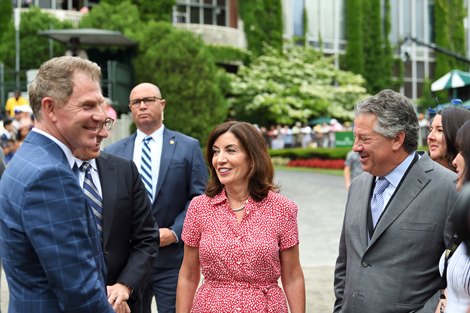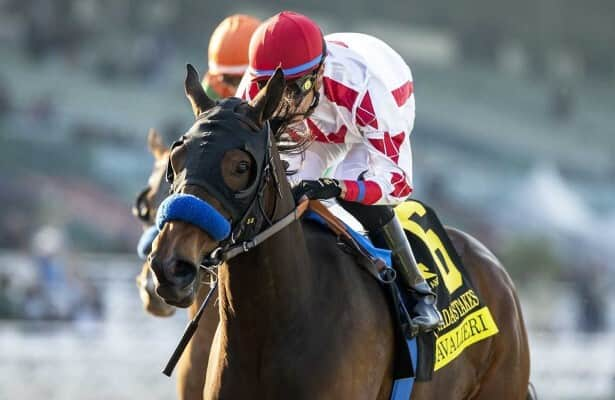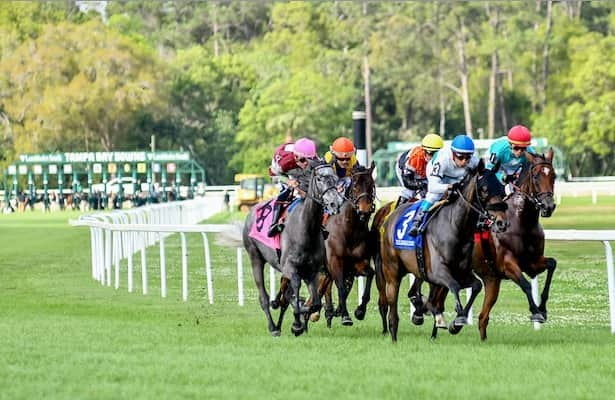New York Gov. Kathy Hochul presented some specifics Jan. 21 to a plan that piggybacks onto a 2024 Assembly proposal to provide funding from the state—and the New York Racing Association—to expand advanced imaging screening at the Cornell Ruffian Equine Specialists hospital adjacent to Belmont Park.
“The long-term viability of Thoroughbred horse racing requires investment into research to reduce the risk of traumatic injury to the equine athlete,” states a document explaining the idea’s need that was buried among more than 10,000 pages of various budget provisions released by the Hochul administration.
“This study will examine whether a more robust screening protocol can be developed to assist in reducing severe injuries before equine athlete races and therefore reduce equine fatalities,” it added.
The idea surfaced last year in a plan put forward by Democrats who run the Assembly. It died during fiscal talks last April when it failed to make it into the final state budget negotiated by Hochul and Democrats who run the Senate and the Assembly.
Like last year’s Assembly plan, Hochul Tuesday embraced an offer by NYRA to provide $2 million to help with equipment purchases and staffing needs at the Ruffian facility. The Hochul budget proposes an additional 1% market origin fee for further funding on out-of-state advance deposit wagering providers. The Assembly last year proposed a tax increase on only the most profitable of ADW companies; the Hochul budget appears to increase the tax on all ADW operators.
In all, the state anticipates $17 million over three years will be raised to go to the Harry M. Zweig Memorial Fund for Equine Research for a longitudinal study on Thoroughbred fetlock joint injury detection. The fetlock and surrounding structures are among the most sensitive locations for catastrophic injuries in racehorses. Cornell’s Ruffian facility would be responsible for the study.
The funds would first all go into the state’s catch-all general fund and would be expended on equine research per agreements between the dean of the Cornell University College of Veterinary Medicine and the executive director of Hochul’s New York State Gaming Commission. If any revenue that is raised does not get spent on the study, then those funds will be kept by the state, Hochul proposed.
Part of a massive “revenue” bill released Tuesday afternoon as part of the budget plan by the Democratic governor, it states that the research is intended to “identify the incident of fetlock fractures and pre-fracture pathology in thoroughbred racehorses, with and without lameness.” It adds the study is to determine “the sensitivity and specificity of computed tomography, positron emission tomography, and magnetic imaging of Thoroughbred racehorses compared to that of digital radiographs.”
It says the screening research will seek to “define early bone pathology in Thoroughbred racehorses that suffer fatal fractures of the fetlock joint” and to “further categorize blood biomarker findings in healthy and clinically lame horses in a large population of Thoroughbred racehorses.”
The research also seeks to refine a “risk factor index for fatal musculoskeletal injury for Thoroughbred racing based on epidemiological findings, preliminary scanning technology, clinical examination, and advance imaging.”
The Hochul budget measure states that “it is incumbent” upon NYRA to “ensure the safety of its equine participants.” It proposes that NYRA transfer the $2 million—which NYRA first floated last year as an amount it would pay for the advanced screening program—by Sept. 1 this year.
A horse gallops during morning training
The state budget is due to be in place before the next fiscal year starts April 1. The Ruffian funding plan is part of an overall $252 billion spending proposal Hochul sent to lawmakers Tuesday afternoon.
NYRA said it embraces equine safety measures “rooted in science and technology” and that the racing corporation is ready to invest in equine imaging “for the benefit of the sport.”
“Continuously improving equine safety is an organizational imperative at NYRA, which is why we have long-supported measures designed to expand access to the most advanced equine imaging available today. We believe this technology holds incredible promise as both a diagnostic tool and pathway for improving scientific research around thoroughbreds in training,” NYRA spokesman Patrick McKenna said after Hochul released her budget proposal.












